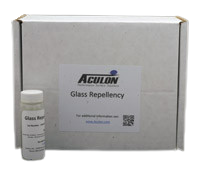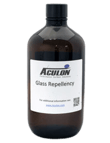Glass Repellency Treatment
- For making glass surfaces hydrophobic and oleophobic
- 2-20 nm thickness
- Easy to apply, optically clear and ultra thin
Product Description
Aculon's glass repellency technology is designed to make glass surfaces hydrophobic, oleophobic, and repellent to nearly any liquid. Aculon's glass treatment is easy to apply, optically clear, and ultra-thin (2-20 nm). This durable treatment is designed for most glass, silicate hard-coated plastic, and ceramic parts and can be applied via several application methods, including dip, wipe, or spray.
Advantages of Aculon's Glass Repellency Treatment
- Hydrophobicity and Oleophobicity
- Repels near all liquids
- Long-lasting repellent performance
Technical Specifications
| General Properties | |||||
| |||||
| Solids | 10 % | ||||
| Specific Gravity Specific Gravity Specific gravity (SG) is the ratio of the density of a substance to the density of a reference substance; equivalently, it is the ratio of the mass of a substance to the mass of a reference substance for the same given volume. For liquids, the reference substance is almost always water (1), while for gases, it is air (1.18) at room temperature. Specific gravity is unitless. | 1.5-1.7 | ||||
| Physical Properties | |||||
| Viscosity Viscosity Viscosity is a measurement of a fluid’s resistance to flow. Viscosity is commonly measured in centiPoise (cP). One cP is defined as the viscosity of water and all other viscosities are derived from this base. MPa is another common unit with a 1:1 conversion to cP. A product like honey would have a much higher viscosity -around 10,000 cPs- compared to water. As a result, honey would flow much slower out of a tipped glass than water would. The viscosity of a material can be decreased with an increase in temperature in order to better suit an application | 2 mPa.s | ||||
| Electrical Properties | |||||
| Visible Light Transmission | >90 % | ||||
| Thermal Properties | |||||
| Boiling Point Boiling Point The amount of degree’s needed to reach in order to make the substance boil. | 129 °C | ||||
| Other Properties | |||||
| Coating Thickness | 2-20 nm | ||||
| Oil Contact Angle Oil Contact Angle The contact angle is the angle, conventionally measure trough the liquid, where a liquid-vapor interface meets a solid surface. | 60 ° | ||||
| Water Contact Angle | 115 ° | ||||
Additional Information
How to apply Aculon's Glass Repellency Treatment
STEP 1 ⇨ CLEAN | STEP 2 ⇨ TREAT | STEP 3 ⇨ DRY |
| Parts must be sufficiently clean before treatment for proper bonding and effective application. This can be accomplished by first degreasing the surface with solvents/rinsing with soap and water. To remove monolayer-scale contaminants, a substrate-specific cleaner is recommended based on the application. | Dip - Fully immerse the part in the treatment solution for 1 minute. Withdraw the part at a steady rate to ensure even coverage. Allow to dry or cure depending on your substrate. |
To dry, the part should be placed at room temperature with 40-50% relative humidity for ≥24 hours. The product may also be cured for 2 hours at 150°C. Higher temperature cures create coatings with increased durability.
|
Wipe - Using a clean cloth apply the treatment by wiping it across the surface in a buffing motion for 1 minute per square foot. | ||
Spray - Spray the solution on the substrate, air dry. If the coating is too thick, reduce the amount applied by changing the settings on the spray gun or using a diluent. | ||
Flow - Dispense the treatment over the surface, applying enough to coat the entire surface. Allow excess material to drain, it is advised to cure for durability. |
Application Tips
- Use a microfiber cloth to wipe after cleaning.
- Coat the substrate as soon as possible after cleaning to prevent recontamination.
- Spray Equipment Suggestions: HVLP(Binks Mach 1), HVLP(Devilbiss JGHV), Air Atomization(Devilbiss MBC gun), and Airless(Graco Model 225-292 President Pump Series A).
- Cure temperatures and conditions should be optimized based on substrate and durability requirements.
How to test for Hydrophobicity
To test for hydrophobicity, allow water droplets to fall onto the surface, which should bead up to a contact angle >90⁰. If the contact angle is <90⁰, then the surface is not
hydrophobic. The surface should be cleaned again and the Glass Repellency Treatment reapplied.
Application Ideas










